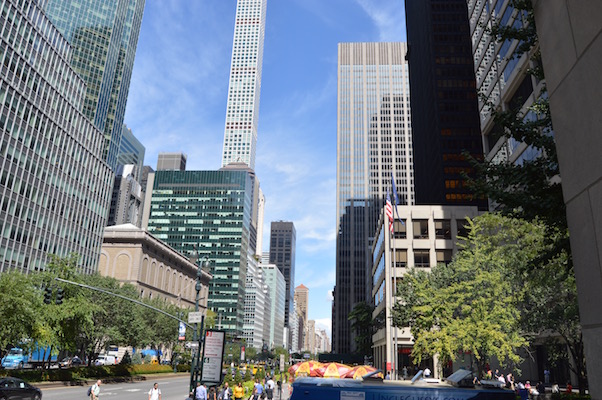
BY JACKSON CHEN | A majority of the Manhattan Borough Board – composed of the borough president, its city councilmembers, and community board chairs – approved the Department of City Planning’s Midtown East rezoning plan on March 16, but noted the action comes while the plan is still in the middle of an evolving review process.
Of the 10 board members present, eight voted in favor and there were two abstentions – from the chairs of Community Boards 5 and 6, which last week both passed resolutions conditionally withholding their support for the plan.
On March 8 and 9, respectively, CB6 and CB5 disapproved the rezoning proposal at full board meetings, citing a lack of serious focus in the plan on incentives for public spaces to be created in tandem with the new development.
The Midtown East rezoning would enable the area from East 39th to East 57th Streets, from Fifth Avenue to Third – with the district extending east to Second Avenue between East 42nd and East 43rd Streets – to operate under different zoning rules than would otherwise apply. The proposal is meant to spur modern office building construction by offering potential developers the chance at more density provided they either buy development rights from landmarked buildings throughout the district or contribute to a public realm improvement project.
After a failed 2013 attempt at a rezoning plan under the Bloomberg administration, the effort officially restarted in October 2015 when the Department of City Planning released its second proposal. Community Boards 5 and 6 joined Borough President Gale Brewer, City Councilmember Dan Garodnick, a variety of city agencies, local groups, and landmarked institutions in months of work that tried to strike a balance among all affected parties.
“We think that we are on a better path to be able to deliver new zoning rules and benefits to the public,” Garodnick said during the Borough Board meeting. “That said, we’re in the middle of ULURP, which means that not all the issues are resolved.”
ULURP is the Uniform Land Use Review Process, a months-long procedure for approving projects with successive oversight by local community boards, the borough president, the City Planning Commission, the City Council, and finally the mayor’s signature.
Garodnick explained that there were still questions of how much of a cut the public realm improvement fund – established to finance transit and open spaces amenities in connection with new development – would receive through the transfer of landmarked building’s development rights, how a governing group would allocate those funds to specific projects, and if the city would deliver on public realm investments upfront, before the new developments are fully constructed.
What largely went unanswered in the Borough Board meeting were concerns raised by CB5 and CB6 in lengthy, detailed resolutions adopted last week.
CB6’s Land Use and Waterfront Committee chair Sandro Sherrod explained that his board’s five-page resolution addressed the most salient points raised by community members, including the desire for more stringent and in-depth requirements on development and public realm improvement incentives that make clear to local residents what can be expected.
The board’s resolution stated “there remain many unresolved issues in a number of major categories,” including open space, Metropolitan Transportation Authority improvements, above-ground public realm improvements, the zoning area’s boundaries, and the impact of sunlight reduction on the streets.
According to CB6, the current rezoning proposal doesn’t treat the options for developers earning higher floor-to-area ratios — or FARs, the total floor space compared to the size of the area the building will be on — equally. The board’s resolution voiced opposition to the incentives for developers to first look to landmarks’ transferrable development rights and transit improvements as sources of a FAR increase before they consider incorporating public open space amenities into their projects. The resolution warned that “above-ground public realm improvements may never materialize” unless the city creates a way to ensure they do.
Among a lengthy list of reservations, CB6 was particularly concerned about building shadows that would reduce access to light and fresh air, the unprecedented levels of traffic and congestion that would follow the rezoning, and the performance and sustainability requirements placed on new buildings.
The board specifically sought to move the eastern border of the rezoning area from east of Third Avenue back to the middle of the avenue to curb the incursion of commercial construction into the Turtle Bay residential neighborhood.
One day following CB6’s vote, CB5 also voted to reject the rezoning, voicing similar concerns about shadows and the uncertainty about open space amenities.
“Community Board Five’s core objective throughout the process was to ensure that the Greater East Midtown planning effort resulted in an improvement to the public realm,” the board’s resolution read.
CB5 rejected the proposal unless the DCP can ensure that there there will be a public space created for each development that uses landmarks’ rights to increase its density.
“We’re quite disappointed with the proposal that has come out, and while there are some positive aspects to what has been put forward, there are really no tangible improvements to the public realm,” said CB5’s Land Use, Housing, and Zoning Committee Chair Eric Stern before the vote.
CB5 also recommended that the Public Realm Improvement Fund — which is currently slated to yield a portion of all landmark rights sales, calculated by whichever is the greater of 20 percent of a total sale value or $78.60 per square foot, one-fifth of the current $393 “floor price” proposed by the DCP — instead receive 30 percent based on the same formula approach.
The board’s resolution also recommended that the governing group being established to manage the public realm improvement fund – to include five mayoral appointees among its nine members – require six affirmative votes to approve projects, so that it won’t become a channel for the mayor to have their improvement ideas rubberstamped.
As part of their resolutions, both boards indicated that should either the DCP or the mayor’s office guarantee that every redevelopment site would be required to include an outdoor public space or a covered pedestrian walkway, their conditional denials would become conditional approvals, subject to other concerns.
Just before the March 16 Borough Board meeting, the two community boards were presented with at least one commitment from city officials aimed at alleviating their concerns.
According to Jim Caras, the borough president’s general counsel and director of land use, the city agreed to include in the environmental impact statement a requirement for indoor and outdoor privately-owned public spaces, or POPS, for projects built on lots that are 40,000 square feet or larger. For a square lot, that would mean dimensions of 200 by 200 feet.
Vikki Barbero, CB5’s chair, said that addition to the Borough Board’s resolution would make a “difference in a vote, but not necessarily a yes vote because we still have some real problems and issues we brought to the forefront.”
Barbero’s neighboring district’s chair, Richard Eggers of CB6, offered similar thoughts that acknowledged the concession, but he added he felt “rushed” and was still not fully on board with the plan.
“This resolution has captured many of the concerns CB6 has raised, takes the whole discussion further, and makes a more cogent presentation for the purposes of future conversations at the various levels throughout the ULURP procedure,” Eggers said. “We expect all the issues raised in our resolution [and] the CB5 resolution to be fully addressed as the proposal goes forward.”
Eggers added that in abstaining he – and his board – didn’t want to get in the way of the proposal’s progress, though he couldn’t bring himself to vote yes at this time.
“I was hell-bent on voting no,” Barbero said at the Borough Board. “The reason I’m abstaining, both [Eggers] and I recognize that there has been movement on this… I don’t want to sound that we’re being ungrateful. We’re feeling so pressured by this, we really would love to vote yes, but we’ve got full boards behind us with unanimous votes.”
With the community board and Borough Board votes, the proposal moves one step closer to being realized, with the matter now going before Brewer for review, and then on to the City Planning Commission and ultimately the City Council.
Joe Marvilli, a spokesperson for the DCP, stressed, though, that the plan is still early in the review process and that the City Planning Commission would carefully weigh the recommendations from the community boards, the Borough Board, Brewer, and public testimony in its deliberations.
“In response to the community’s clearly stated priorities, the rezoning will deliver transit upgrades and public realm improvements concurrent with new development,” Marvilli said in a statement. “We appreciate and welcome the additional input.”




































